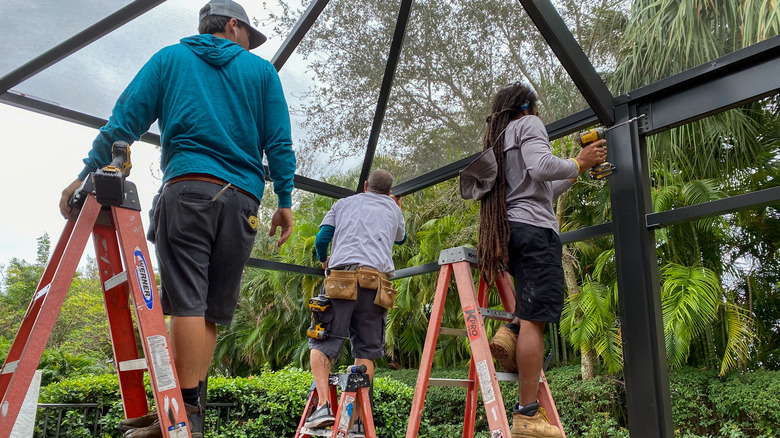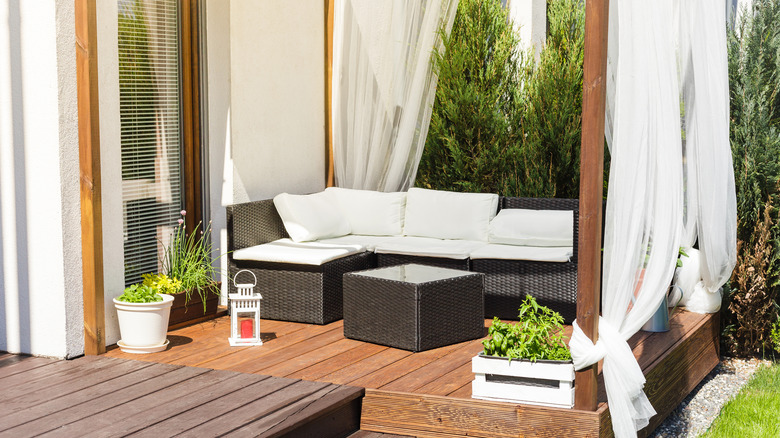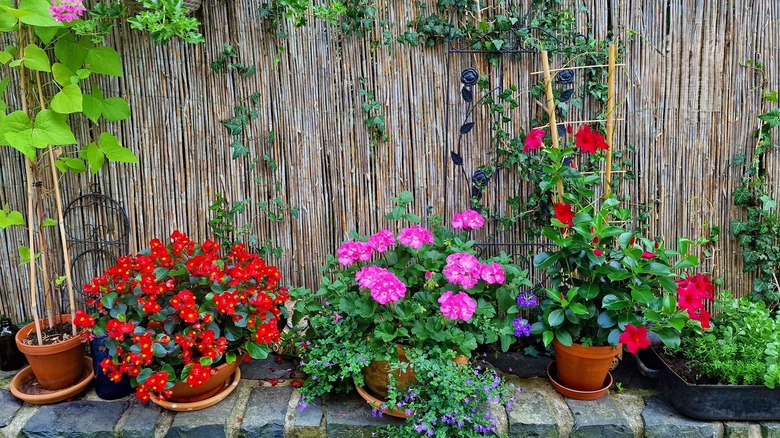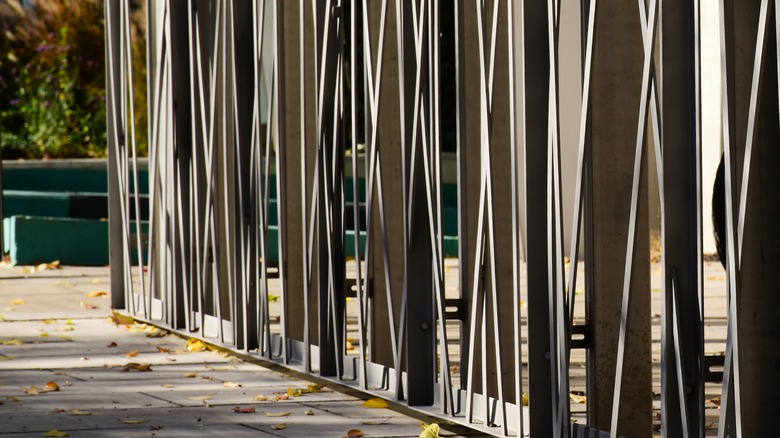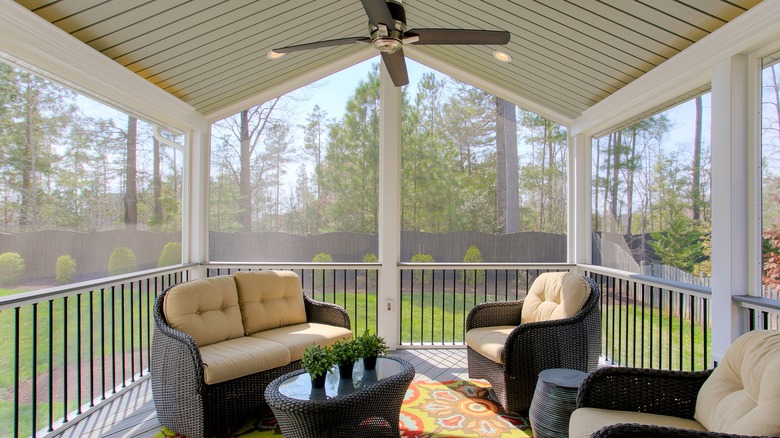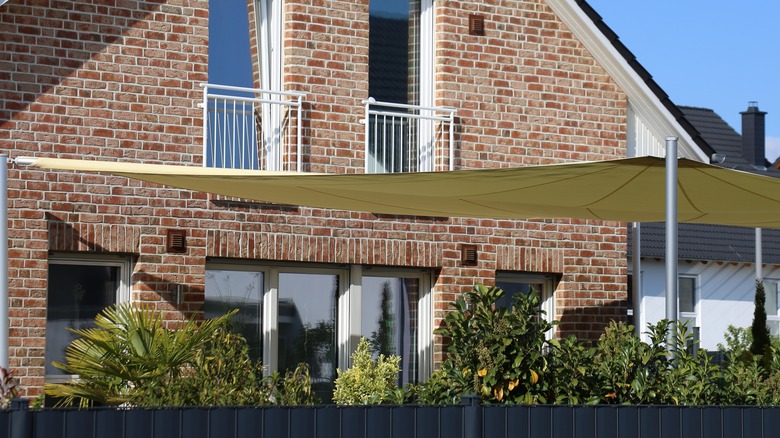Budget-Friendly Ways To DIY A Patio Enclosure
We may receive a commission on purchases made from links.
A patio is an outdoor oasis, where we come to enjoy fresh air, gentle natural light, and the sight of wildlife and vegetation. But this very same space can often leave us exposed to unforgiving sunlight, unpleasant wind gusts, annoying mosquitoes, and nosy neighbors. Patio enclosures give us a way to still enjoy the outdoors, while erecting an unobtrusive barrier to protect us from the worst of the elements and lack of privacy. And the good news is that you don't need to hire professionals and spend thousands of dollars on a sunroom addition just to enjoy this balance. There are plenty of ways that don't cost much to enclose a patio and lend themselves perfectly to DIY installation.
Some common, DIY- and wallet-friendly patio enclosures include outdoor drapes, reed, willow, and bamboo fencing, metal and fabric screens, and shade sails. Each of these solutions serves a similar purpose but has unique functionality, so you'll have to understand how these enclosure types work to know if they align with your needs. Below, we explain how each enclosure type works, and touch on installation steps, costs, pros, and cons.
Outdoor drapes are the least expensive way to enclose a patio
Outdoor drapes offer one of the simplest and most budget-friendly ways to enclose a patio, with a single, 80-inch panel typically costing around $20 — like this one at Wayfair. You can use outdoor drapes to create some privacy in your outdoor space, block relentless sun, and keep insects, pollen, and wind at bay. This type of patio enclosure serves an aesthetic purpose as well, as the drapes imbue your patio with a cozy, airy atmosphere.
Some outdoor curtains come with grommets that fit a standard curtain rod (the rod should be rust-free). To install outdoor drapes, you simply have to slide the rods through the drapes' grommets, then mount the curtain rods to the trellis, pergola, or gazebo with weather-proof fasteners. The curtains function much like the drapes you hang inside, except the fabric is weather-resistant, so the drapes continue to look brand-new despite constant exposure to sun and moisture. Drapes with UV resistance can maintain their original color instead of fading in the sun. Meanwhile, moisture-proof outdoor curtains are designed to not develop mold or mildew in moist or humid conditions.
That said, not all outdoor drapes are designed with the above attributes, nor sufficient quality needed to withstand prolonged outdoor use. When choosing your drapes, check the label to see if the product is made to resist UV rays and whether it's been treated against mold and mildew. Fabrics made with polyethylene tend to last the longest in this application. Also, opt for heavier fabrics if you live in a windy place, as the weight will keep the drapes steadier on gusty days.
Reed, willow, or bamboo fences offer an inexpensive way to create a tropical atmosphere
If you're after a more organic look for your patio enclosure, consider installing reed, willow, or bamboo fencing. These natural materials give off a tiki bar, tropical vibe, so the style may well work for you if you use the patio to entertain guests with al fresco dining and libations. Whether you choose reed, willow, or bamboo, you'll need a rigid structure to support these panels. So, if you don't have, say, a chain link fence surrounding your patio, you'll need to set up vertical fence posts with horizontal stringers around the patio's perimeter. Then, you'll have to fasten the panels to these supports.
Reed, willow, and bamboo fencing materials are somewhat similar in appearance, but all come with their pros and cons. Reed is by far the cheapest, costing as little as $30 for a 16-foot roll. Apart from the low price point, reed excels in versatility — the material is extremely flexible, so you can create virtually any shape you like with a roll of reed fencing. Being extremely lightweight, reed is also easy enough to handle during installation. On the other hand, reed deteriorates and loses its natural color after prolonged exposure to the elements. Willow fencing is significantly pricier than reed, at around $180 for a 6-foot-long panel. The loftier price tag buys you greater durability, as the sturdier willow generally outlasts reed, with a lifespan of up to 10 years compared to reed's four. The price of bamboo is up there with willow, and you should expect to pay at least $120 for a 6-foot panel. Bamboo outlasts the other two materials, with a lifespan of roughly 20 years.
Metal privacy screens are easy to install, but harder on the wallet
You have countless options for using metal screens to enclose your patio. Like outdoor drapes and bamboo fencing, these screens afford privacy and block the sun and wind. Typically, these screens are either completely freestanding, or they come with metal posts you can affix them to yourself. This configuration gives metal screens the obvious advantage of effortless installation, which involves nothing more than setting them in place, or attaching them to metal posts included with the package. Some of the models also come with different fasteners you can use to anchor the screen's legs to the ground. Don't worry about weather exposure, either — most of these panels are made from either galvanized metal or aluminum, both of which boast long-term resistance to corrosion.
When you think of metal panels, you don't have to associate it with the tough, industrial (and arguably ugly) look of corrugated metal. Nowadays, there are plenty of elegant, ornate metal privacy screens that are quite beautiful, like this freestanding option from HomeDepot. If you look around online, you can find a wide assortment of metal outdoor privacy screens of different sizes and patterns. One significant limiting factor for these panels is their high price point. Whereas you'll pay just over $100 for an 8-foot section of bamboo fencing, and even less for drapes, a 3-foot metal screen will set you back over $300. Prepare to pay more than double this amount if you want the screen to come with fancier features, like an integral planter for your flowers.
Screened patio enclosures give you respite from mosquitoes
Are you looking to protect your patio from mosquitoes or other pesky insects? You will be able to equip your patio with screens, like these ones from Porch Enclosure Systems. These screens are sold together with DIY installation kits, which include everything you need to fasten the screens to various materials, like vinyl, aluminum, wood, or masonry. If your outdoor area doesn't have a roof or ceiling from which to hang the screens, you can opt for posts and make it a floor-mounted solution. Typically, a no-frills patio screen will cost you just under $40 for a 6-foot-tall section that's 12 feet long.
Some manufacturers, like MosquitoCurtains, offer screens that come with tracks and resemble curtains. With this configuration, the screens are arguably less of an eyesore — especially if you choose a color that matches or complements the exterior decor. These screens are also designed for simple DIY installation, and all you need to do is affix the tracks to a ceiling or soffit, and then suspend the curtains from the track. Obviously, this option only works if your outdoor area has a roof of some sort.
Do you want the patio enclosure to block out the sun and wind, and give you some privacy on top of keeping insects away? Then consider a more comprehensive solution, like this retractable system from PatioConcepts. A system like this one is wind-resistant, comes in colors that can obscure your patio from view, has solar-blocking qualities, and retracts into its cassette automatically. Considering all these extras, it's not surprising that these screens aren't cheap — the model we mentioned above costs over $2,000.
Shade sails enclose your patio from the top
If you enjoy having an open patio but would like to have some sun protection, consider investing in a shade sail. A shade sail is a piece of fabric meant to block the sun and cast a shadow below. These contraptions usually come in a triangular or rectangular shape, and so have three or four anchor points through which you attach them to structures around your patio. You can affix shade sails to the posts of a trellis, your home's roof, an exterior wall, or any other surface that makes a sturdy anchor point. If you're struggling to find at least three suitable points (these would accommodate a triangular sail), you can install a post to serve as one. Installation is relatively simple — just follow the manufacturer's instructions and affix the supplied anchors into the points. Then fasten the sail to them, corner by corner, before tightening the sail using turnbuckles.
Shade sails are relatively inexpensive. For example, this 16-by-16-foot sail costs under $60 at ShelterLogic. Apart from the price, consider the sail's shape, size, color, and fabric type when you buy one. The preferred aesthetic and possible anchor points should dictate both shape and size. For example, if you have three potential anchor points and the maximum distance between them is 12 feet, then opt for a triangular sail that's a bit smaller 12 feet wide on each side. If you want a durable sail that stands up well to sun and rain, opt for one made from high-density polyethylene, which is the most robust fabric for such applications. The best shade sail color is entirely subjective, so as long as it aligns with your expectations and works with the surrounding decor, you should be fine.
